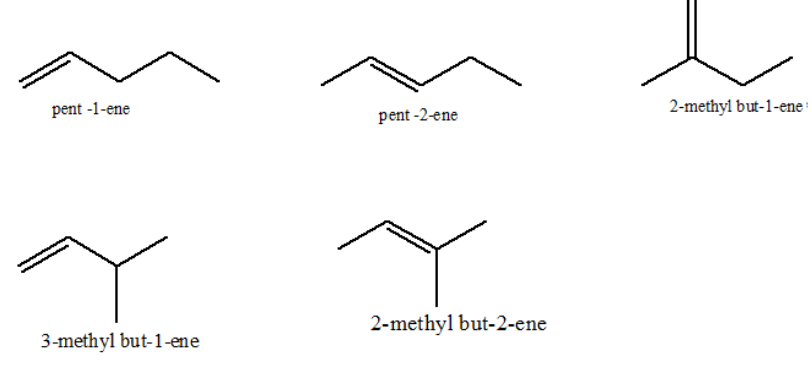
The number of structural isomers of pentene is:
A.3
B.4
C.5
D.6
Answer
528k+ views
Hint: It can have chain isomers, position isomers, and ring chain isomers. But do not possess functional group isomers. The number of isomers can be determined by changing the position of methyl groups w.r.t. the double bond.
Complete step-by-step answer:Isomers are those molecules which have the same molecular formula but physical, chemical and biological properties can be different. Structural isomers are those having the same molecular formula but different properties due to different structures such as chain, position, functional group, linking property, etc. Functional group isomers are those structural isomers which have the same molecular formula but different functional groups. Chain isomers are those structural isomers which have the same molecular formula but have different lengths of principle carbon chain or parent carbon chain as per IUPAC. Position isomers are those structural isomers which have the same molecular formula but are different in position of functional group, multiple bond or substituent. Ring chain isomers are those structural isomers which have the same molecular formula but have either multiple bonds or ring with respect to its isomer.
For example structural isomers possible for \[{{\text{C}}_4}{{\text{H}}_8}\] are 5. These are as follow:

Similarly, possible structural isomers for pentene are 5:

Thus, the correct option is C.
Note: As changing the position of double bond in an organic compound containing alkene makes a different isomer. Other isomers of pentene can be drawn by changing the way that the carbon atoms are joined to each other or by changing the place of double bond. Isomers have the same chemical formula but different properties, like straight chain compounds have higher surface area than branched alkanes and thus have higher Vander Waal force of attraction and higher boiling and melting point.
Complete step-by-step answer:Isomers are those molecules which have the same molecular formula but physical, chemical and biological properties can be different. Structural isomers are those having the same molecular formula but different properties due to different structures such as chain, position, functional group, linking property, etc. Functional group isomers are those structural isomers which have the same molecular formula but different functional groups. Chain isomers are those structural isomers which have the same molecular formula but have different lengths of principle carbon chain or parent carbon chain as per IUPAC. Position isomers are those structural isomers which have the same molecular formula but are different in position of functional group, multiple bond or substituent. Ring chain isomers are those structural isomers which have the same molecular formula but have either multiple bonds or ring with respect to its isomer.
For example structural isomers possible for \[{{\text{C}}_4}{{\text{H}}_8}\] are 5. These are as follow:

Similarly, possible structural isomers for pentene are 5:

Thus, the correct option is C.
Note: As changing the position of double bond in an organic compound containing alkene makes a different isomer. Other isomers of pentene can be drawn by changing the way that the carbon atoms are joined to each other or by changing the place of double bond. Isomers have the same chemical formula but different properties, like straight chain compounds have higher surface area than branched alkanes and thus have higher Vander Waal force of attraction and higher boiling and melting point.
Recently Updated Pages
Master Class 12 Business Studies: Engaging Questions & Answers for Success

Master Class 12 Economics: Engaging Questions & Answers for Success

Master Class 12 English: Engaging Questions & Answers for Success

Master Class 12 Maths: Engaging Questions & Answers for Success

Master Class 12 Social Science: Engaging Questions & Answers for Success

Master Class 12 Chemistry: Engaging Questions & Answers for Success

Trending doubts
What is meant by exothermic and endothermic reactions class 11 chemistry CBSE

Which animal has three hearts class 11 biology CBSE

10 examples of friction in our daily life

One Metric ton is equal to kg A 10000 B 1000 C 100 class 11 physics CBSE

1 Quintal is equal to a 110 kg b 10 kg c 100kg d 1000 class 11 physics CBSE

Difference Between Prokaryotic Cells and Eukaryotic Cells




